英语论文格式要求
毕业生英语论文格式要求_论文格式_
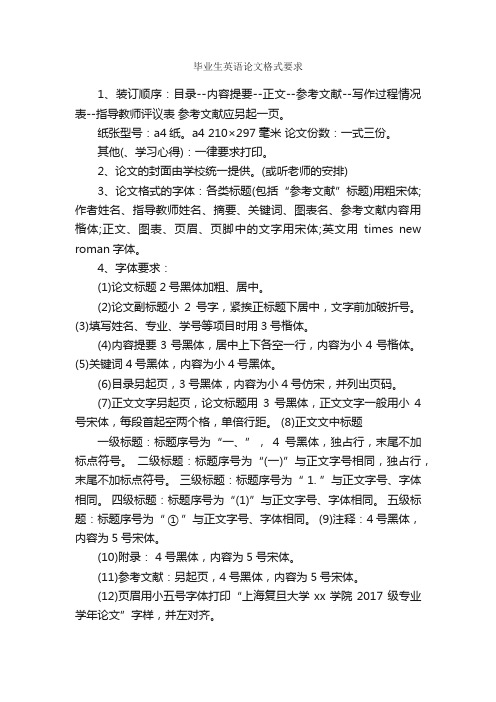
毕业生英语论文格式要求1、装订顺序:目录--内容提要--正文--参考文献--写作过程情况表--指导教师评议表参考文献应另起一页。
纸张型号:a4纸。
a4 210×297毫米论文份数:一式三份。
其他(、学习心得):一律要求打印。
2、论文的封面由学校统一提供。
(或听老师的安排)3、论文格式的字体:各类标题(包括“参考文献”标题)用粗宋体;作者姓名、指导教师姓名、摘要、关键词、图表名、参考文献内容用楷体;正文、图表、页眉、页脚中的文字用宋体;英文用times new roman字体。
4、字体要求:(1)论文标题2号黑体加粗、居中。
(2)论文副标题小2号字,紧挨正标题下居中,文字前加破折号。
(3)填写姓名、专业、学号等项目时用3号楷体。
(4)内容提要3号黑体,居中上下各空一行,内容为小4号楷体。
(5)关键词4号黑体,内容为小4号黑体。
(6)目录另起页,3号黑体,内容为小4号仿宋,并列出页码。
(7)正文文字另起页,论文标题用3号黑体,正文文字一般用小4 号宋体,每段首起空两个格,单倍行距。
(8)正文文中标题一级标题:标题序号为“一、”,4号黑体,独占行,末尾不加标点符号。
二级标题:标题序号为“(一)”与正文字号相同,独占行,末尾不加标点符号。
三级标题:标题序号为“ 1. ”与正文字号、字体相同。
四级标题:标题序号为“(1)”与正文字号、字体相同。
五级标题:标题序号为“ ① ”与正文字号、字体相同。
(9)注释:4号黑体,内容为5号宋体。
(10)附录: 4号黑体,内容为5号宋体。
(11)参考文献:另起页,4号黑体,内容为5号宋体。
(12)页眉用小五号字体打印“上海复旦大学xx学院2017级专业学年论文”字样,并左对齐。
5、纸型及页边距:a4纸(297mm×210mm)。
6、页边距:天头(上)20mm,地角(下)15mm,订口(左)25mm,翻口(右)20mm。
7、装订要求:先将目录、内容摘要、正文、参考文献、写作过程情况表、指导教师评议表等装订好,然后套装在学校统一印制的论文封面之内(用胶水粘贴,订书钉不能露在封面外)。
英语论文格式与引用注释规范
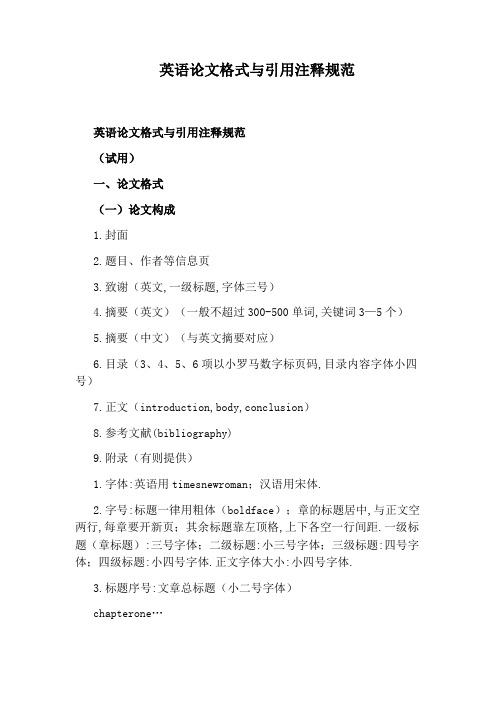
英语论文格式与引用注释规范英语论文格式与引用注释规范(试用)一、论文格式(一)论文构成1.封面2.题目、作者等信息页3.致谢(英文,一级标题,字体三号)4.摘要(英文)(一般不超过300-500单词,关键词3—5个)5.摘要(中文)(与英文摘要对应)6.目录(3、4、5、6项以小罗马数字标页码,目录内容字体小四号)7.正文(introduction,body,conclusion)8.参考文献(bibliography)9.附录(有则提供)1.字体:英语用timesnewroman;汉语用宋体.2.字号:标题一律用粗体(boldface);章的标题居中,与正文空两行,每章要开新页;其余标题靠左顶格,上下各空一行间距.一级标题(章标题):三号字体;二级标题:小三号字体;三级标题:四号字体;四级标题:小四号字体.正文字体大小:小四号字体.3.标题序号:文章总标题(小二号字体)chapterone…1.11.1.11.1.1.1…2.12.1.14.引文:少于四行的直接引文置于双引号内;超过四行(包括四行)的引文要与正文隔开,上下各空一行,左边缩进10个字母;如所引原文第一行有缩进,则该行在论文中再缩进三个字母的间距,即引文第一行缩进13个字符;字体小1号使用(即五号字体);行距为1.5.图表:图表应有与内容相符的明确标题;图的标记以第二章图一为例则为:figure2—1,依此类推;表的标记以第二章表一为例则为:table2—1,依此类推.6.行距:除四行及以上引文行距为1外,全文为1.25倍或18磅.二、引文注释规范1.注释或引用分为文内注和文末参考文献两种形式.文内注置于圆括号内,紧跟在引用内容之后;应标出作者姓(名)和页码,之间不用标点,如(bhabha120),若同一作者有多部著作引用,则应在作者姓后分别注出该著作出版年份,如,(weiss1998:76)、(weiss2002:104),等.若在文内已提供被引用者姓名,则只要将引文页码置于圆括号内.若引文文献著者有同姓者,应提供其名的首字母.若著者为多位,可在第一位著者姓之后用“等等”(etal.),也可提供所有著者姓,之间用逗号分隔.若著者为汉语姓氏,提供汉字全名,以免混淆.若引文页码有起止范围,在起止页码之间用单横线连接;若页码有两个及以上,中间用逗号分隔.若引用为间接来源,则应第一引用者姓(名)前注出“转引自”(qtd.in)字样.文内注示例:briantavessuggestssomeinterestingconclusionsregardingthe philosophyandpoliticsoftheadventurefilm(153-54,171).georgemayberry,writinginthenewrepublic,referredto itasa“deeplyandtragicallyhuman”story(108);andedwinj.lukas,inthea nnalsoftheamericanacademyofpoliticalandsocialscience,hailed itasessentialreadingforprofessionalsconcernedwiththecrimina lpersonality(216).theauthorsofwomen’swaysofknowingmakeadistinctionbetween “separateknowing”and“connectedknowing”(belenkyetal.100-30).(多位作者也可以注出所有著者姓,中间用逗号分隔.)。
英语论文格式字号
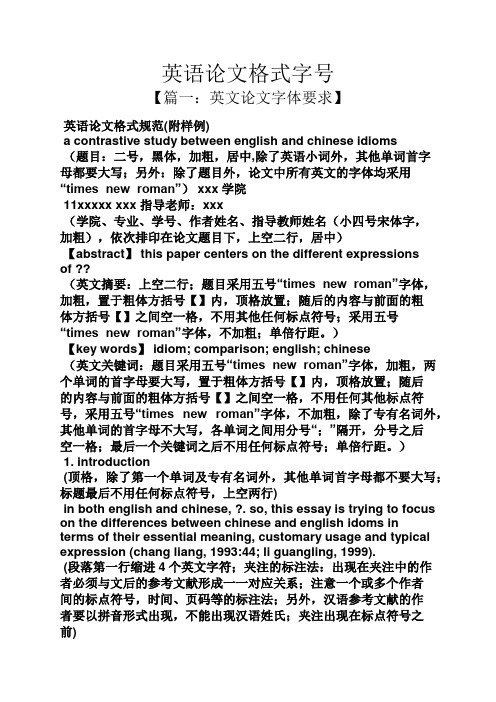
英语论文格式字号【篇一:英文论文字体要求】英语论文格式规范(附样例)a contrastive study between english and chinese idioms(题目:二号,黑体,加粗,居中,除了英语小词外,其他单词首字母都要大写;另外:除了题目外,论文中所有英文的字体均采用“times new roman”) xxx学院11xxxxx xxx 指导老师:xxx(学院、专业、学号、作者姓名、指导教师姓名(小四号宋体字,加粗),依次排印在论文题目下,上空二行,居中)【abstract】 this paper centers on the different expressionsof ??(英文摘要:上空二行;题目采用五号“times new roman”字体,加粗,置于粗体方括号【】内,顶格放置;随后的内容与前面的粗体方括号【】之间空一格,不用其他任何标点符号;采用五号“times new roman”字体,不加粗;单倍行距。
)【key words】 idiom; comparison; english; chinese(英文关键词:题目采用五号“times new roman”字体,加粗,两个单词的首字母要大写,置于粗体方括号【】内,顶格放置;随后的内容与前面的粗体方括号【】之间空一格,不用任何其他标点符号,采用五号“times new roman”字体,不加粗,除了专有名词外,其他单词的首字母不大写,各单词之间用分号“;”隔开,分号之后空一格;最后一个关键词之后不用任何标点符号;单倍行距。
)1. introduction(顶格,除了第一个单词及专有名词外,其他单词首字母都不要大写;标题最后不用任何标点符号,上空两行)in both english and chinese, ?. so, this essay is trying to focus on the differences between chinese and english idoms interms of their essential meaning, customary usage and typical expression (chang liang, 1993:44; li guangling, 1999).(段落第一行缩进4个英文字符;夹注的标注法:出现在夹注中的作者必须与文后的参考文献形成一一对应关系;注意一个或多个作者间的标点符号,时间、页码等的标注法;另外,汉语参考文献的作者要以拼音形式出现,不能出现汉语姓氏;夹注出现在标点符号之前)2. the similarities between english idioms and chinese idiomsin english, ?. and it can be clearly seen in the below examples:(1) i don’t know。
英语论文格式
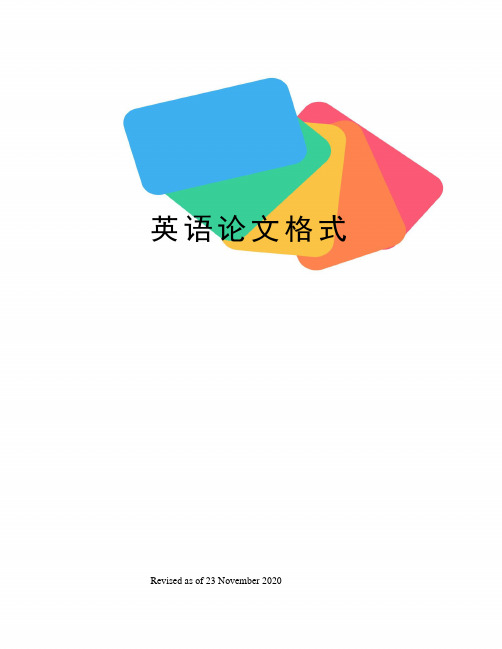
英语论文格式 Revised as of 23 November 2020英文论文的格式通常,学校发的论文写作规定会对一篇Assignment应该写成Essay还是 Report格式作出明确要求。
两种格式的相同之处:1、字体:Times New Roman,字号:小四,行距:倍(也有双倍间距的)。
请有写作之前就把这些格式调好,以避免写好后再调节,会造成不必要的麻烦。
2、段落之间空一行,每段不要求像中文写作那样空两格,而是直接顶格写。
两种格式的不同之处:一、Essay?Essay 的写作相对Report要简单一些。
通常只包括三个部分,绪论(Introduction), 主体(Main Body),结论(Conclusion)。
绪论(Introduction)包括选题(topic)的背景介绍和文章要解决的主要问题,通常占总字数的 10%左右。
主体(Main Body)占总字数80%左右。
如果题目中作了具体要求,就根据题目提到的几个方面来逐一讨论就可以了。
有的题目没有作具体要求,就根据自己的构思来写。
但要求有逻辑性。
结论(Conclusion)也是占10%,在这一段里把文章中的主要观点用一到两句话概括出来。
Essay 可以不写题目,不要把小标题加粗。
二、Report:它的写法大体上和essay差不多,但要求要严格一些。
1、标题页:包括标题和executive summary. Executive summary是对文章的摘要,这两个部分一般是单独占一页。
2、主体部分:Report的主体部分,前三个和essay差不多,只是在conclusion后还有一部分就是recommendations,是对提出的问题的建议。
如果题目中没有单独要求,一般就按照这几部分来写,但有的题目会作出规定。
请按题目要求写哪几部分来写。
Reference?Reference 是几乎所有老师最看重的,所以请一定注意。
1、不管前面的主体部分最后一页剩多少空格,reference都要另起一页写;2、每条reference之间要空一行。
英文论文的详细格式(英文论文写作格式)
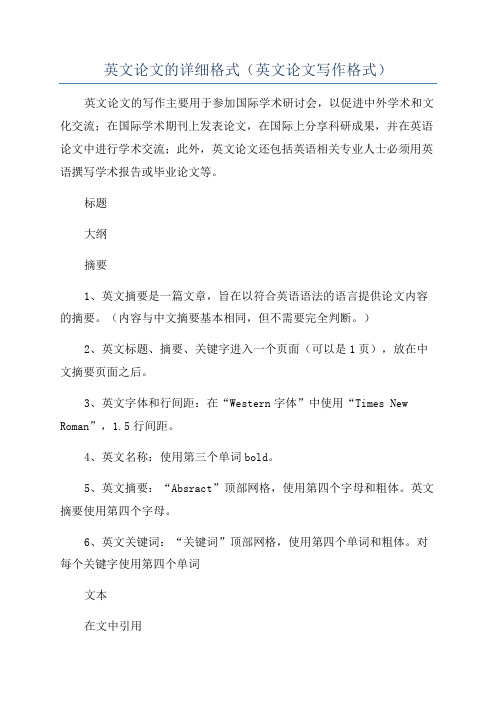
英文论文的详细格式(英文论文写作格式)英文论文的写作主要用于参加国际学术研讨会,以促进中外学术和文化交流;在国际学术期刊上发表论文,在国际上分享科研成果,并在英语论文中进行学术交流;此外,英文论文还包括英语相关专业人士必须用英语撰写学术报告或毕业论文等。
标题大纲摘要1、英文摘要是一篇文章,旨在以符合英语语法的语言提供论文内容的摘要。
(内容与中文摘要基本相同,但不需要完全判断。
)2、英文标题、摘要、关键字进入一个页面(可以是1页),放在中文摘要页面之后。
3、英文字体和行间距:在“Western字体”中使用“Times New Roman”,1.5行间距。
4、英文名称:使用第三个单词bold。
5、英文摘要:“Absract”顶部网格,使用第四个字母和粗体。
英文摘要使用第四个字母。
6、英文关键词:“关键词”顶部网格,使用第四个单词和粗体。
对每个关键字使用第四个单词文本在文中引用如果引用少于三行,则引文可以有机地整合到纸张中。
如果要引用的单词具有与需要删除的纸张无关的单词,则需要省略号。
如果省略号出现在引文中,请使用三个点。
如果它出现在引文的末尾,请使用四个点。
最后一个点表示句点并放在第二个括号之后(通常,避免在引用开始时使用省略号);点和字母之间或点和点之间的空格。
参考书目每个项目的第一行需要打印在顶部网格中,并且所有行都需要缩进五次以区分该项目与其他项目。
英文摘要英文论文摘要,也称为摘要,是论文的重要组成部分。
它旨在提供文献内容的摘要,没有评论和补充说明。
一篇简短的文章,准确描述了文献的重要内容。
摘要应该是独立和不言而喻的,并且与文献具有相同数量的信息,即,可以在不阅读全文的情况下获得重要信息。
摘要通常放在标题之后,即文章的第一篇。
在论文发表后,论文的摘要经常被文献检索系统收集。
英文摘要一般为200-300个单词,并且有一个与英文抽象表达相对应的中文摘要。
,。
英文标准论文格式要求
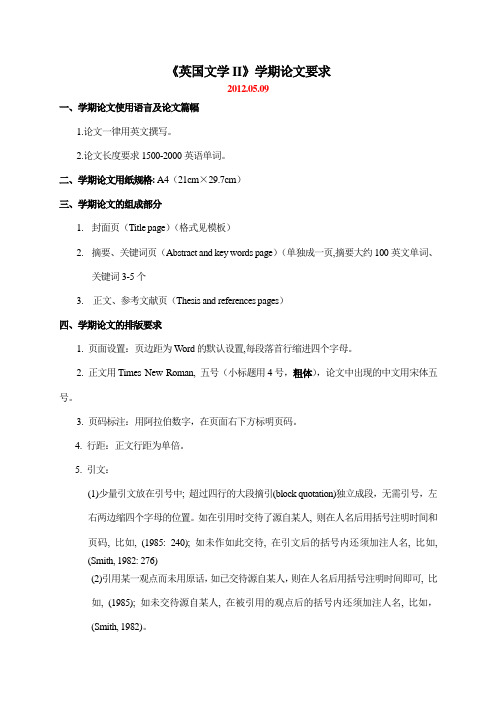
《英国文学II》学期论文要求2012.05.09一、学期论文使用语言及论文篇幅1.论文一律用英文撰写。
2.论文长度要求1500-2000英语单词。
二、学期论文用纸规格: A4(21cm×29.7cm)三、学期论文的组成部分1.封面页(Title page)(格式见模板)2.摘要、关键词页(Abstract and key words page)(单独成一页,摘要大约100英文单词、关键词3-5个3. 正文、参考文献页(Thesis and references pages)四、学期论文的排版要求1. 页面设置:页边距为Word的默认设置,每段落首行缩进四个字母。
2. 正文用Times New Roman, 五号(小标题用4号,粗体),论文中出现的中文用宋体五号。
3. 页码标注:用阿拉伯数字,在页面右下方标明页码。
4. 行距:正文行距为单倍。
5. 引文:(1)少量引文放在引号中; 超过四行的大段摘引(block quotation)独立成段,无需引号,左右两边缩四个字母的位置。
如在引用时交待了源自某人, 则在人名后用括号注明时间和页码, 比如, (1985: 240); 如未作如此交待, 在引文后的括号内还须加注人名, 比如, (Smith, 1982: 276)(2)引用某一观点而未用原话,如已交待源自某人,则在人名后用括号注明时间即可, 比如, (1985); 如未交待源自某人, 在被引用的观点后的括号内还须加注人名, 比如,(Smith, 1982)。
(3)人名和时间等须和参考文献中的一致。
6. 标题对齐方式:论文中的各级标题一律左对齐。
一级标题用“1.…”的格式标注,二级标题用“1.1 …”,三级“1.1.1 …”,比如:1.…1.1 …1.1.1 …1.1.2 …1.2 …1.2.1 …1.2.2 …2.…2.1 …2.1.1 ……依此类推。
五、学期论文参考文献要求1.参考文献的数量要求:不少于5种(其中英文文献不少于2种),先列英文参考文献,后列中文参考文献。
英语本科毕业论文撰写要求格式1.论文全篇除一级标题外,字体一律小
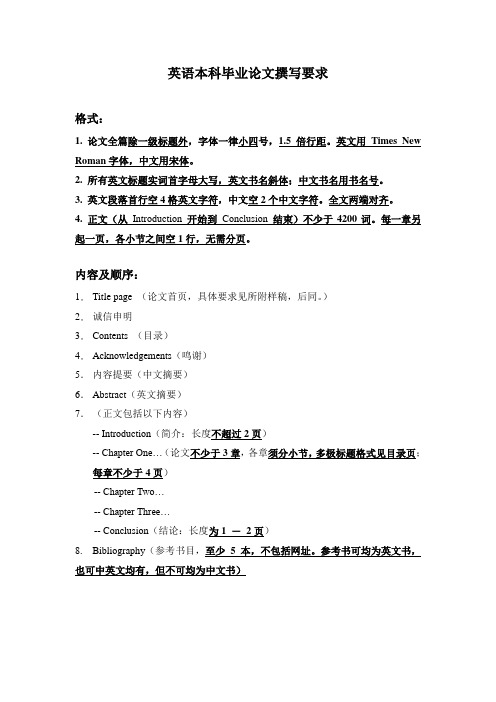
英语本科毕业论文撰写要求格式:1. 论文全篇除一级标题外,字体一律小四号,1.5倍行距。
英文用Times New Roman字体,中文用宋体。
2. 所有英文标题实词首字母大写,英文书名斜体;中文书名用书名号。
3. 英文段落首行空4格英文字符,中文空2个中文字符。
全文两端对齐。
4. 正文(从Introduction开始到Conclusion结束)不少于4200词。
每一章另起一页,各小节之间空1行,无需分页。
内容及顺序:1.Title page (论文首页,具体要求见所附样稿,后同。
)2.诚信申明3.Contents (目录)4.Acknowledgements(鸣谢)5.内容提要(中文摘要)6.Abstract(英文摘要)7.(正文包括以下内容)-- Introduction(简介:长度不超过2页)-- Chapter One…(论文不少于3章,各章须分小节,多极标题格式见目录页;每章不少于4页)-- Chapter Two…-- Chapter Three…-- Conclusion(结论:长度为1 -2页)8. Bibliography(参考书目,至少5本,不包括网址。
参考书可均为英文书,也可中英文均有,但不可均为中文书)样稿(论文首页)Dream Shattered-- A Tentative Analysis of Martin Eden(论文题目,小二号字,该页其余部分四号字。
加粗,居中,实词首字母大写)A Paper Presented toCollege of Continuing EducationShanghai International Studies UniversityIn Partial Fulfillment of the RequirementsFor the Degree of Bachelor of ArtsBy WANG Meiyuan(自己姓名,姓大写,名首字母大写)Under the Supervision ofMr.(或)Ms. Xxx(导师姓名,姓大写,名首字母大写)(空1行)December, 2011(论文定稿完成年月)Contents(所有大标题居中,小三号字,加粗,与下文之间空1行)(论文大小标题以名词或分词短语构成,须提纲挈领。
英语毕业论文格式要求及写作方法
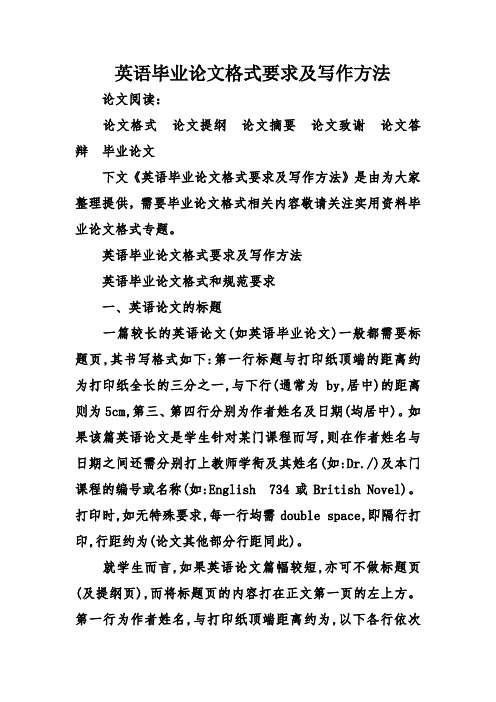
英语毕业论文格式要求及写作方法论文阅读:论文格式论文提纲论文摘要论文致谢论文答辩毕业论文下文《英语毕业论文格式要求及写作方法》是由为大家整理提供,需要毕业论文格式相关内容敬请关注实用资料毕业论文格式专题。
英语毕业论文格式要求及写作方法英语毕业论文格式和规范要求一、英语论文的标题一篇较长的英语论文(如英语毕业论文)一般都需要标题页,其书写格式如下:第一行标题与打印纸顶端的距离约为打印纸全长的三分之一,与下行(通常为by,居中)的距离则为5cm,第三、第四行分别为作者姓名及日期(均居中)。
如果该篇英语论文是学生针对某门课程而写,则在作者姓名与日期之间还需分别打上教师学衔及其姓名(如:Dr./)及本门课程的编号或名称(如:English 734或British Novel)。
打印时,如无特殊要求,每一行均需double space,即隔行打印,行距约为(论文其他部分行距同此)。
就学生而言,如果英语论文篇幅较短,亦可不做标题页(及提纲页),而将标题页的内容打在正文第一页的左上方。
第一行为作者姓名,与打印纸顶端距离约为,以下各行依次为教师学衔和姓、课程编号(或名称)及日期;各行左边上下对齐,并留出左右的页边空白(下同)。
接下来便是论文标题及正文(日期与标题之间及标题与正文第一行之间只需隔行打印,不必留出更多空白)。
二、英语论文提纲英语论文提纲页包括论题句及提纲本身,其规范格式如下:先在第一行(与打印纸顶端的距离仍为左右)的始端打上Thesis 一词及冒号,空一格后再打论题句,回行时左边须与论题句的第一个字母上下对齐。
主要纲目以大写罗马数字标出,次要纲目则依次用大写英文字母、阿拉伯数字和小写英文字母标出。
各数字或字母后均为一句点,空出一格后再打该项内容的第一个字母;处于同一等级的纲目,其上下行左边必须对齐。
需要注意的是,同等重要的纲目必须是两个以上,即:有Ⅰ应有Ⅱ,有A应有B,以此类推。
如果英文论文提纲较长,需两页纸,则第二页须在右上角用小写罗马数字标出页码,即ii(第一页无需标页码)。
英语论文格式要求

英语论文格式要求英语论文的格式要求通常包括以下几个方面:1.封面:在封面上应包括论文的标题、作者的姓名、指导教师的姓名、所属机构和日期等信息。
2.摘要:摘要应简明扼要地介绍论文的研究目的、方法、主要结果和结论,并尽量使用简洁明了的语言。
4.引言:介绍论文的背景和目的,提出研究问题,并对本研究与已有研究的关系进行阐述。
5.文献综述:对已有文献进行综合评述,提供有关研究领域中的相关理论和研究结果。
6.方法:描述研究设计、数据采集和分析方法,以及实施研究的详细步骤。
7.结果:以文字、表格、图表等形式展示研究的主要结果,并对结果进行分析和讨论。
8.讨论:对研究结果进行解释、分析和讨论,阐明研究的意义、局限性和未来研究方向。
9.结论:总结论文的主要发现和结论,再次强调研究的意义和贡献。
11.附录:如果有需要附加的材料,可以将其放在附录中,例如详细的数据表格、统计分析的结果等。
另外,论文的格式要求还包括以下几个方面:1. 字体和字号:通常要求使用12号标准字体,如Times New Roman或Arial。
2.行距和间距:一般要求使用1.5倍行距,并在段落之间留有适当间距。
3.页面设置:通常要求页面边距设置为2.5厘米,页眉和页脚设置为2厘米。
4.标题和标题样式:标题应采用阿拉伯数字依次编号,标题样式一般要求使用粗体或大写字母。
5.引用格式:论文中的引用应符合特定的引用格式和引文样式,如APA(美国心理学协会)、MLA(现代语言协会)等。
6.图片和表格:如果论文中有插图或表格,应给予适当的标题和编号,并在正文中进行解释和引用。
以上是一般英语论文的格式要求,具体要求可能会根据学校和学者的要求而有所不同。
在撰写论文时,最好参考相关的学术期刊或指南来确定具体的格式要求。
英语论文格式
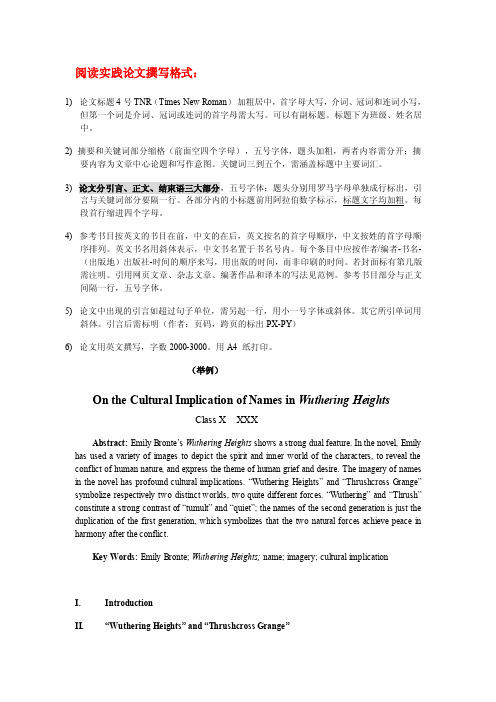
阅读实践论文撰写格式:1) 论文标题4号TNR(Times New Roman)加粗居中,首字母大写,介词、冠词和连词小写,但第一个词是介词、冠词或连词的首字母需大写。
可以有副标题。
标题下为班级、姓名居中。
2) 摘要和关键词部分缩格(前面空四个字母),五号字体,题头加粗,两者内容需分开;摘要内容为文章中心论题和写作意图。
关键词三到五个,需涵盖标题中主要词汇。
3) 论文分引言、正文、结束语三大部分,五号字体;题头分别用罗马字母单独成行标出,引言与关键词部分要隔一行。
各部分内的小标题前用阿拉伯数字标示,标题文字均加粗。
每段首行缩进四个字母。
4) 参考书目按英文的书目在前,中文的在后,英文按名的首字母顺序,中文按姓的首字母顺序排列。
英文书名用斜体表示,中文书名置于书名号内。
每个条目中应按作者/编者-书名-(出版地)出版社-时间的顺序来写,用出版的时间,而非印刷的时间。
若封面标有第几版需注明。
引用网页文章、杂志文章、编著作品和译本的写法见范例。
参考书目部分与正文间隔一行,五号字体。
5) 论文中出现的引言如超过句子单位,需另起一行,用小一号字体或斜体。
其它所引单词用斜体。
引言后需标明(作者:页码,跨页的标出PX-PY)6) 论文用英文撰写,字数2000-3000。
用A4 纸打印。
(举例)On the Cultural Implication of Names in Wuthering HeightsClass X XXXAbstract:Emily Bronte’s Wuthering Heights shows a strong dual feature. In the novel, Emily has used a variety of images to depict the spirit and inner world of the characters, to reveal the conflict of human nature, and express the theme of human grief and desire. The imagery of names in the novel has profound cultural implications. “Wuthering Heights”and “Thrushcross Grange”symbolize respectively two distinct worlds, two quite different forces. “Wuthering” and “Thrush”constitute a strong contrast of “tumult” and “quiet”; the names of the second generation is just the duplication of the first generation, which symbolizes that the two natural forces achieve peace in harmony after the conflict.Key Words:Emily Bronte; Wuthering Heights; name; imagery; cultural implicationI.IntroductionII.“Wuthering Heights” and “Thrushcross Grange”2.12.2III. “Catherine Linton” and “Catherine Earnshaw”3.13.23.3IV. Conclusion.References:(举例)[1] Aristotle. “Rhetoric.” Trans. W.R. Roberts. The Works of Aristotle. Ed. W. D. Ross. Oxford:Clarendon Press,1924.[2] Brodkey, Linda. “Review: The Language in Metaphor.” College English.v50(Jan 1988):89-94.[3] Davis, Anthony R. and Jean-Pierre Koenig. “ Linking as Constraints on Word Classes in aHierarchical Lexicon.” Language. 76. 1. (2000): 56-91.[4] Goatly, Andrew. The Language of Metaphors. London: Routledge 11, New Fetter Lane, 1997.[5] Jin Di & Eugene A. Nida. On Translation. Beijing: China Translation Publishing Company,1984.[6] Lakoff, G. and M. Johnson. Metaphors We Live by. Chicago: U of Chicago P, 1987.[7] Nida, Eugene A. and William Reyburn. Meaning Across Cultures. New Y ork: Orbis Book,1981.[8] 陈宏薇. 新实用汉译英教程[M]. 武汉:湖北教育出版社,1996.[9] 胡文仲. 文化与交际[M]. 北京:外语教学与研究出版社,1994.[10] 徐丽娜. “隐喻的翻译.”[J] 中国翻译. 3(1999):84-91.网络类:著者.题名[EB/OL].www.***.com.年-月-日.。
英语专业毕业论文格式要求规范

英语专业毕业论文格式要求规范1.内封(英文)《内封》说明:l 标题“三号字加粗”全部大写,其它信息“四号字加粗”, 书名斜体;l 所有内容居中,字体用Times New Roman;l 姓名采用拼音形式,注意姓名的表达方式;l 本页无页码。
2.英文摘要《英文摘要》说明:l 要求长度150-300 单词,3-5 个关键词;l 本页采用字体Times New Romanl 关键词之间用分号隔开;l “Abstract”独行居中,四号字加粗;l “Key words”四号字加粗;l 其他信息均采用小四号字(或英文12 号字);l 本页无页码;l 本页行距为多倍行距(1.25),英文摘要内容控制在一页3.中文摘要《中文摘要》说明:l 本页所有信息采用汉字“宋体”;l 中文标题居中,小三号字加粗;l 若有书名,加书名号;l “摘要”和“关键词”四号字加粗,其他内容小四号字, 关键词之间用分号隔开;l 本页无页码, 中文摘要长度300-500 字,多倍行距(1.25),控制在一页以内4.目录《目录》说明:l 本页采用字体Times New Roman;l “Contents”应为复数,四号字加粗居中;l 所有章节标题用小四号字,第一级标题加粗;l 各级标题应与文中一致,首字母大写格式;l 章节目录一般列到第二级即可,若因文章需要,最多可列至第三级;l 标题编码统一采用阿拉伯数字从“1”开始;l 注意:一级标题与其序号间“点和空格”,二级和三级标题与其序号间“空格”(文中相同);l “Acknowledgements(致谢)”为必需项,正文尾页;5. 正文《正文》说明:l 从本页开始设置页码,“下居中”,从1 开始;l 文章标题小三号字加粗居中,实词首字母大写l 各级章节标题均顶头加粗,除第一级标题用四号字外,其余各级标题均用小四号字;l 每完成一个章(节),空一行,再进入下一章(节)。
l 正文文字每个段落前缩进4 个字符(4 个字母的位置),全文字体Times New Roman;l 直接和间接引用的观点均应标明出处(方法:夹注。
英语论文格式字号
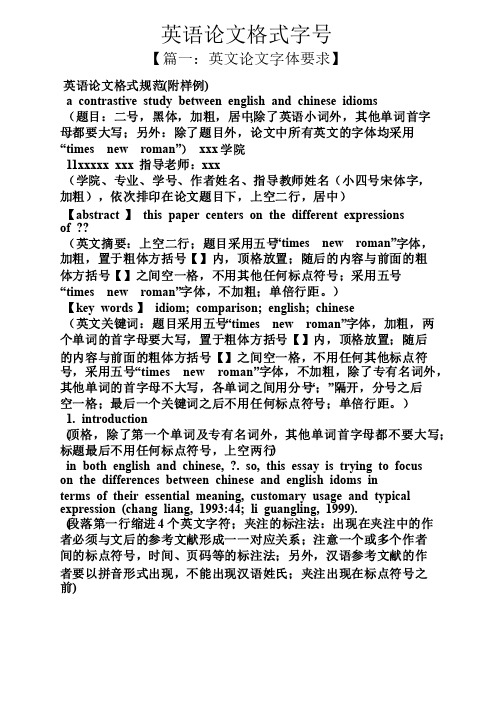
英语论文格式字号【篇一:英文论文字体要求】英语论文格式规范(附样例) a contrastive study between english and chinese idioms(题目:二号,黑体,加粗,居中,除了英语小词外,其他单词首字母都要大写;另外:除了题目外,论文中所有英文的字体均采用“times new roman”) xxx学院 11xxxxx xxx 指导老师:xxx(学院、专业、学号、作者姓名、指导教师姓名(小四号宋体字,加粗),依次排印在论文题目下,上空二行,居中)【abstract】 this paper centers on the different expressions of ??(英文摘要:上空二行;题目采用五号“times new roman”字体,加粗,置于粗体方括号【】内,顶格放置;随后的内容与前面的粗体方括号【】之间空一格,不用其他任何标点符号;采用五号“times new roman”字体,不加粗;单倍行距。
)【key words】 idiom; comparison; english; chinese(英文关键词:题目采用五号“times new roman”字体,加粗,两个单词的首字母要大写,置于粗体方括号【】内,顶格放置;随后的内容与前面的粗体方括号【】之间空一格,不用任何其他标点符号,采用五号“times new roman”字体,不加粗,除了专有名词外,其他单词的首字母不大写,各单词之间用分号“;”隔开,分号之后空一格;最后一个关键词之后不用任何标点符号;单倍行距。
) 1. introduction (顶格,除了第一个单词及专有名词外,其他单词首字母都不要大写;标题最后不用任何标点符号,上空两行) in both english and chinese, ?. so, this essay is trying to focus on the differences between chinese and english idoms in terms of their essential meaning, customary usage and typical expression (chang liang, 1993:44; li guangling, 1999). (段落第一行缩进4个英文字符;夹注的标注法:出现在夹注中的作者必须与文后的参考文献形成一一对应关系;注意一个或多个作者间的标点符号,时间、页码等的标注法;另外,汉语参考文献的作者要以拼音形式出现,不能出现汉语姓氏;夹注出现在标点符号之前) 2. the similarities between english idioms and chinese idioms in english, ?. and it can be clearly seen in the below examples: (1) i don’t know。
英语毕业论文格式的基本要求有些

英语毕业论文格式的基本要求有些
1.论文标题:应简明扼要、准确地概括研究内容。
2.摘要:应简明扼要地介绍论文的目的、方法、结果和结论,通常不
超过250字。
3.关键词:列出3-5个论文研究的核心关键词。
4.引言:介绍研究的背景、目的和意义,并对相关研究进行综述。
5.研究方法:详细描述所采用的研究方法、实验设计和数据分析方法。
6.结果:按逻辑顺序呈现实验结果或理论分析,并配以合适的图表和
表格。
7.讨论:对研究结果进行分析和解释,并与已有研究进行比较和讨论。
8.结论:对研究的主要发现进行总结,并提出可能的进一步研究方向。
10.附录:如有需要,可以在论文的附录中提供详细的数据、图表或
其他相关材料。
此外,还需注意以下事项:
-论文应使用标准的英语语法和拼写,避免语法错误和拼写错误。
-论文应具有逻辑性,段落之间和章节之间的内容应有一定的连贯性。
-论文中使用的图表和表格应清晰易读,并有相应的标题和编号。
-引用他人研究时应注明出处,避免抄袭行为。
-论文要使用合适的学术语言,避免使用俚语或口语化的表达方式。
当然,具体论文格式还需根据所在学校或教师的要求进行调整和修改。
所以,在撰写论文之前,建议仔细阅读毕业论文的指导要求,并与导师进
行沟通,确保符合相关的要求。
英语论文写作格式要求
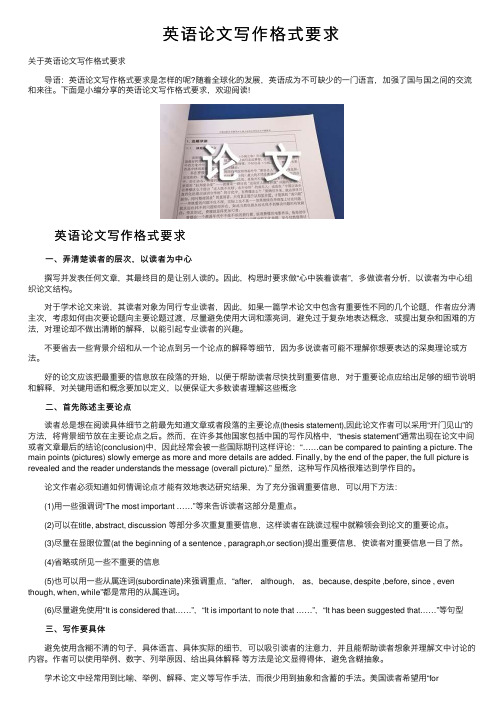
英语论⽂写作格式要求关于英语论⽂写作格式要求 导语:英语论⽂写作格式要求是怎样的呢?随着全球化的发展,英语成为不可缺少的⼀门语⾔,加强了国与国之间的交流和来往。
下⾯是⼩编分享的英语论⽂写作格式要求,欢迎阅读! 英语论⽂写作格式要求 ⼀、弄清楚读者的层次,以读者为中⼼ 撰写并发表任何⽂章,其最终⽬的是让别⼈读的。
因此,构思时要求做“⼼中装着读者”,多做读者分析,以读者为中⼼组织论⽂结构。
对于学术论⽂来说,其读者对象为同⾏专业读者,因此,如果⼀篇学术论⽂中包含有重要性不同的⼏个论题,作者应分清主次,考虑如何由次要论题向主要论题过渡,尽量避免使⽤⼤词和漂亮词,避免过于复杂地表达概念,或提出复杂和困难的⽅法,对理论却不做出清晰的解释,以能引起专业读者的兴趣。
不要省去⼀些背景介绍和从⼀个论点到另⼀个论点的解释等细节,因为多说读者可能不理解你想要表达的深奥理论或⽅法。
好的论⽂应该把最重要的信息放在段落的开始,以便于帮助读者尽快找到重要信息,对于重要论点应给出⾜够的细节说明和解释,对关键⽤语和概念要加以定义,以便保证⼤多数读者理解这些概念 ⼆、⾸先陈述主要论点 读者总是想在阅读具体细节之前最先知道⽂章或者段落的主要论点(thesis statement),因此论⽂作者可以采⽤“开门见⼭”的⽅法,将背景细节放在主要论点之后。
然⽽,在许多其他国家包括中国的写作风格中,“thesis statement”通常出现在论⽂中间或者⽂章最后的结论(conclusion)中,因此经常会被⼀些国际期刊这样评论:“……can be compared to painting a picture. The main points (pictures) slowly emerge as more and more details are added. Finally, by the end of the paper, the full picture is revealed and the reader understands the message (overall picture).” 显然,这种写作风格很难达到学作⽬的。
英语专业毕业论文格式基本要求规范
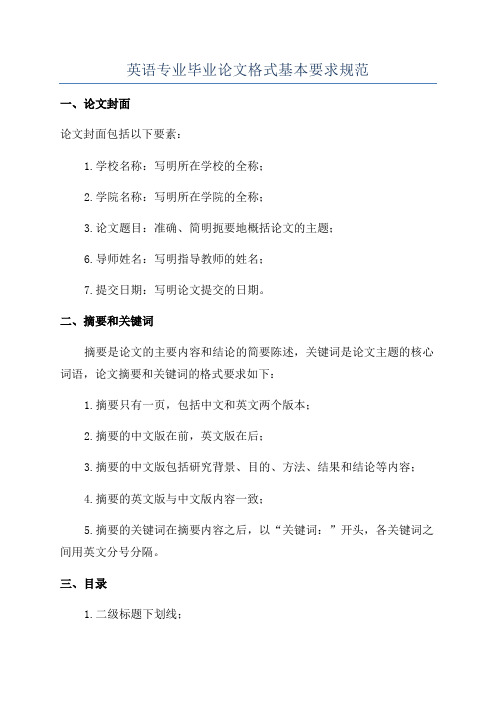
英语专业毕业论文格式基本要求规范
一、论文封面
论文封面包括以下要素:
1.学校名称:写明所在学校的全称;
2.学院名称:写明所在学院的全称;
3.论文题目:准确、简明扼要地概括论文的主题;
6.导师姓名:写明指导教师的姓名;
7.提交日期:写明论文提交的日期。
二、摘要和关键词
摘要是论文的主要内容和结论的简要陈述,关键词是论文主题的核心词语,论文摘要和关键词的格式要求如下:
1.摘要只有一页,包括中文和英文两个版本;
2.摘要的中文版在前,英文版在后;
3.摘要的中文版包括研究背景、目的、方法、结果和结论等内容;
4.摘要的英文版与中文版内容一致;
5.摘要的关键词在摘要内容之后,以“关键词:”开头,各关键词之间用英文分号分隔。
三、目录
1.二级标题下划线;
2.三级标题左缩进;
4.目录的标题为“目录”,不加序号;
四、引言
引言是论文的开篇部分,用于说明研究的背景、目的和意义,引言的
格式要求如下:
1.引言标题加粗,居中;
2.引言内容首行缩进,一般包括研究背景、研究目的和研究意义;
3.引言部分不加章节编号。
五、正文
正文是论文的核心部分,包括研究的过程、结果和讨论等,正文的格
式要求如下:
1.正文的标题按章节进行编号,如1、2、3;
2.正文内容首行缩进,字体一般使用宋体,字号一般为小四号;
3.正文中涉及的外文引用需要用斜体表示;
4.正文中的图表需要有编号和标题,编号分别在上或下,标题在下方;
5.正文的每一节之间需要进行换行和空两行;
6.正文结尾一般包括总结和展望部分。
英语毕业论文排版格式要求
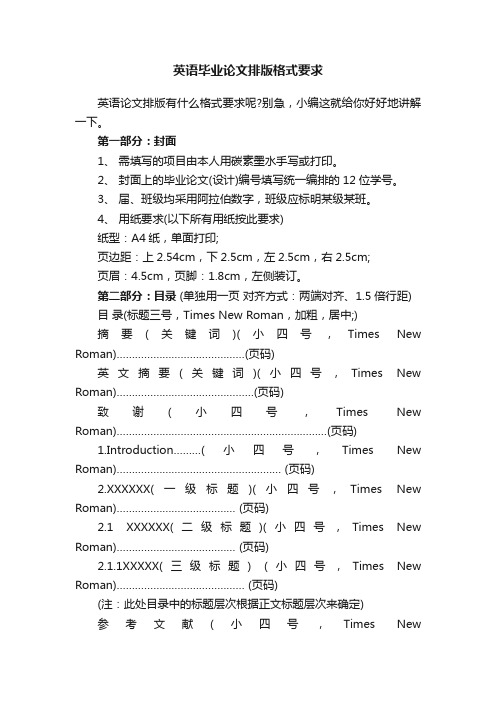
英语毕业论文排版格式要求英语论文排版有什么格式要求呢?别急,小编这就给你好好地讲解一下。
第一部分:封面1、需填写的项目由本人用碳素墨水手写或打印。
2、封面上的毕业论文(设计)编号填写统一编排的12位学号。
3、届、班级均采用阿拉伯数字,班级应标明某级某班。
4、用纸要求(以下所有用纸按此要求)纸型:A4纸,单面打印;页边距:上2.54cm,下2.5cm,左2.5cm,右2.5cm;页眉:4.5cm,页脚:1.8cm,左侧装订。
第二部分:目录 (单独用一页对齐方式:两端对齐、1.5倍行距) 目录(标题三号,Times New Roman,加粗,居中;)摘要(关键词)(小四号,Times New Roman)……………………………………(页码)英文摘要(关键词)(小四号,Times New Roman)………………………………………(页码)致谢(小四号,Times New Roman)……………………………………………………………(页码)1.Introduction………(小四号,Times New Roman)……………………………………………… (页码)2.XXXXXX(一级标题)(小四号,Times New Roman)………………………………… (页码)2.1 XXXXXX(二级标题)(小四号,Times New Roman)………………………………… (页码)2.1.1XXXXX(三级标题) (小四号,Times New Roman)…………………………………… (页码)(注:此处目录中的标题层次根据正文标题层次来确定)参考文献(小四号,Times NewRoman)………………………………………………………(页码)第三部分:文章标题、摘要与关键词1. 文章标题:二号、Times New Roman、加粗、居中题目:应在20个单词以内,能简明、具体、确切地表达论文的特定内容。
必要时可使用副标题;2.中文摘要、关键词(中英文关键词、摘要段落:左右缩进2 个字符)摘要:(小三号,黑体,加粗,居中)摘要正文(小四号,宋体,双倍行距)关键词:标题(小四号,黑体,顶格,加粗)关键词正文(小四号,宋体,词间逗号隔开)3.英文摘要、英文关键词英文摘要标题Abstract:(小三号,Times New Roman,加粗,居中)英文摘要正文(小四号,Times New Roman,双倍行距)英文关键词标题Key words:(小四号,Times New Roman,加粗,顶格)英文关键词正文(小四号,Times New Roman,词间用逗号隔开) 第四部分:主体部分正文:论文正文都必须包括引言(introduction),正体、结束语(conclusion)论点正确、逻辑性强、文理通顺、层次分明、表达确切。
英语论文写作要求
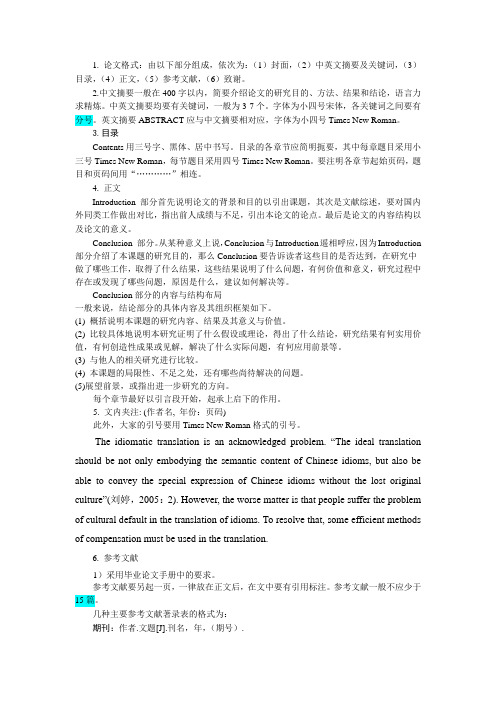
1. 论文格式:由以下部分组成,依次为:(1)封面,(2)中英文摘要及关键词,(3)目录,(4)正文,(5)参考文献,(6)致谢。
2.中文摘要一般在400字以内,简要介绍论文的研究目的、方法、结果和结论,语言力求精炼。
中英文摘要均要有关键词,一般为3-7个。
字体为小四号宋体,各关键词之间要有分号。
英文摘要ABSTRACT应与中文摘要相对应,字体为小四号Times New Roman。
3.目录Contents用三号字、黑体、居中书写。
目录的各章节应简明扼要,其中每章题目采用小三号Times New Roman,每节题目采用四号Times New Roman。
要注明各章节起始页码,题目和页码间用“…………”相连。
4. 正文Introduction 部分首先说明论文的背景和目的以引出课題,其次是文献综述,要对国内外同类工作做出对比,指出前人成绩与不足,引出本论文的论点。
最后是论文的内容结构以及论文的意义。
Conclusion 部分。
从某种意义上说,Conclusion与Introduction遥相呼应,因为Introduction 部分介绍了本课题的研究目的,那么Conclusion要告诉读者这些目的是否达到,在研究中做了哪些工作,取得了什么结果,这些结果说明了什么问题,有何价值和意义,研究过程中存在或发现了哪些问题,原因是什么,建议如何解决等。
Conclusion部分的内容与结构布局一般来说,结论部分的具体内容及其组织框架如下。
(1) 概括说明本课题的研究内容、结果及其意义与价值。
(2) 比较具体地说明本研究证明了什么假设或理论,得出了什么结论,研究结果有何实用价值,有何创造性成果或见解,解决了什么实际问题,有何应用前景等。
(3) 与他人的相关研究进行比较。
(4) 本课题的局限性、不足之处,还有哪些尚待解决的问题。
(5)展望前景,或指出进一步研究的方向。
每个章节最好以引言段开始,起承上启下的作用。
5. 文内夹注: (作者名, 年份:页码)此外,大家的引号要用Times New Roman格式的引号。
英语论文写作格式要求
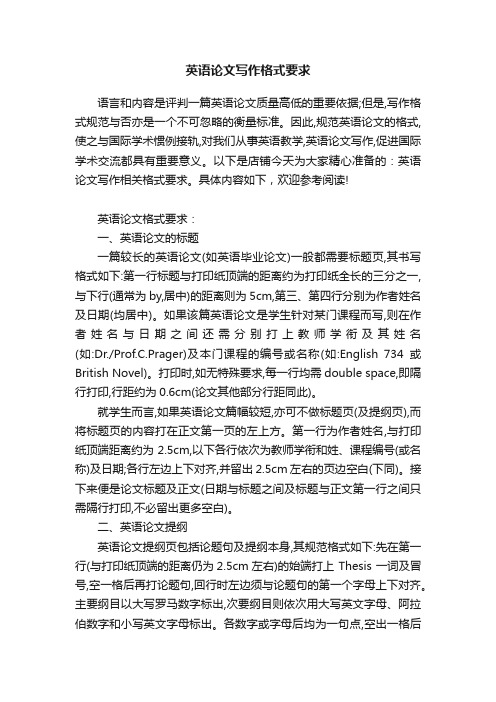
英语论文写作格式要求语言和内容是评判一篇英语论文质量高低的重要依据;但是,写作格式规范与否亦是一个不可忽略的衡量标准。
因此,规范英语论文的格式,使之与国际学术惯例接轨,对我们从事英语教学,英语论文写作,促进国际学术交流都具有重要意义。
以下是店铺今天为大家精心准备的:英语论文写作相关格式要求。
具体内容如下,欢迎参考阅读!英语论文格式要求:一、英语论文的标题一篇较长的英语论文(如英语毕业论文)一般都需要标题页,其书写格式如下:第一行标题与打印纸顶端的距离约为打印纸全长的三分之一,与下行(通常为by,居中)的距离则为5cm,第三、第四行分别为作者姓名及日期(均居中)。
如果该篇英语论文是学生针对某门课程而写,则在作者姓名与日期之间还需分别打上教师学衔及其姓名(如:Dr./Prof.C.Prager)及本门课程的编号或名称(如:English 734或British Novel)。
打印时,如无特殊要求,每一行均需double space,即隔行打印,行距约为0.6cm(论文其他部分行距同此)。
就学生而言,如果英语论文篇幅较短,亦可不做标题页(及提纲页),而将标题页的内容打在正文第一页的左上方。
第一行为作者姓名,与打印纸顶端距离约为2.5cm,以下各行依次为教师学衔和姓、课程编号(或名称)及日期;各行左边上下对齐,并留出2.5cm左右的页边空白(下同)。
接下来便是论文标题及正文(日期与标题之间及标题与正文第一行之间只需隔行打印,不必留出更多空白)。
二、英语论文提纲英语论文提纲页包括论题句及提纲本身,其规范格式如下:先在第一行(与打印纸顶端的距离仍为2.5cm左右)的始端打上 Thesis 一词及冒号,空一格后再打论题句,回行时左边须与论题句的第一个字母上下对齐。
主要纲目以大写罗马数字标出,次要纲目则依次用大写英文字母、阿拉伯数字和小写英文字母标出。
各数字或字母后均为一句点,空出一格后再打该项内容的第一个字母;处于同一等级的纲目,其上下行左边必须对齐。
- 1、下载文档前请自行甄别文档内容的完整性,平台不提供额外的编辑、内容补充、找答案等附加服务。
- 2、"仅部分预览"的文档,不可在线预览部分如存在完整性等问题,可反馈申请退款(可完整预览的文档不适用该条件!)。
- 3、如文档侵犯您的权益,请联系客服反馈,我们会尽快为您处理(人工客服工作时间:9:00-18:30)。
本科生毕业论文(设计)题目:记忆策略在英语学习中的应用学院:外国语学院专业:英语(师范)班级序号:1班18号学号:20051154010155学生姓名:XX指导教师:XX2011年5月The Application of Memory Strategy in English LearningLi QianA Thesis SubmittedIn Partial fulfillment for theRequirements of the Degree ofBACHELOR OF ARTSSchool of Foreign LanguagesLIAONING NORMAL UNIVERSITYMay, 2011AbstractM emory is the most important factor in one’s intelligence ,and most people get good memory by means of proper training. Memory also plays an important part in English teaching. Thus nowadays many foreign language teachers unify memory strategy into the process of English teaching and obtain the remarkable teaching effect. The application of memory strategy has been studied from different perspectives, for example, from psycholinguistics' perspective, the cognitive psychology perspective, and from the linguistics perspective. However, no matter what methods the teacher uses, the final goal is to help the students to use the appropriate memory strategy to improve the efficiency of English learning.By clarifying something about the content of memory theory, elaborating the memory effect of learning under different stages and the important factors of affecting memory, this paper aims to point out the classification of memory strategy, analyzing the memorization of vocabulary, sentence and discourse. It also discusses how the teachers apply memory strategy to teaching practice and unifies the characteristics of original teaching.Keywords: English learning; memory; memory strategy (注意:关键词3-5个,词与词之间用分号分开,除专有名词外,其他单词首字母不大写)Times New Roman 、小三、加粗, 空两行Times New Roman 、,空一行,小四、1.5倍行距 每段缩4个字母摘要记忆力是一个人的智力因素中最重要的部分,大部分人的良好的记忆力是训练出来的。
同时,记忆在英语教学中起到很重要的作用,由此,现今许多外语教师在教课的过程中利用记忆策略与英语教学相结合都得到了显著的教学效果。
很多国内外教育家从不同角度提出了记忆策略的应用,例如,从心理语言学的角度,从认知心理学角度以及从语言学的角度进行研究。
然而,无论教师采用什么方式教学,最终目的都是希望帮助学生使用合适的记忆策略提高英语学习效率。
本文通过简明阐述了记忆理论方面的内容,以及论述不同个体在不同阶段学习的记忆效果和影响学习者记忆效果的重要因素,指出记忆策略的分类,分析英语单词、句子和语篇的记忆学习过程,并探讨教师如何把记忆策略应用到教学实践中并与原教学特点结合。
关键词:英语学习;记忆;记忆策略;Table of ContentsChapter One Introduction..................................................................................................1 Chapter Two Literature Review....................................................................................2 2.1 The Concept of Memory .......................................................................................... 2 2.2 Stages of Memory ...........................................................................................................3 2.3 Standard Model of Memory ............................................................................................4 2.4 Influences of Forgetting .. (5)Chapter Three The Application of Memory Strategy (7)3.1 Strategies of Memory (7)3.1.1 The definition of memory strategy (7)3.1.2 The classification of memory strategy (8)3.1.3 Strategies of memory for different individuals (9)3.2 The Application of Memory Strategy for English Acquisition (10)3.2.1 The process of English acquisition (11)3.2.2 The memorization of English vocabulary (11)3.2.2.1 Pronouncing ...............................................................................................11 3.2.2.2 Picture/Imagery ..........................................................................................11 3.2.2.3 Word formation ..........................................................................................12 3.2.3 The memorization of English sentence .................................................................12 3.2.3.1 Pure repetition: rote learning ......................................................................12 3..2.3.2 Paring ..........................................................................................................12 3.2.3.3 Chunk construction . (13)3.2.4 The Memorization of English Discourse (13)3.2.4.1 Method of loci (13)3.2.4.2 Organization (14)3.2.4.3 Association (14)Chapter Four Conclusion (15)Works Cited (16)Acknowledgements (18)Times New Roman 、小三、加粗、居中空一行 一级标题、小四、TimesNewRoman 、加粗,首字母大写 二级标题、 小四、Times New Roman 、不加粗、缩进3个字母三级标题、小四、TimesNewRoman 、不加粗、缩进6个字母Chapter OneIntroductionThrough the observation of the students ’ language learning process, it is discovered that many students can not remember English words effectively. One reason is that they adopt a mechanical method to memorize the words or sentences. So if the students want to make aIn the past decades, many educational experts have done the researches about memory, as well as the memory rules. Based on memory theory, chapter three elaborates something about memory strategies, including the development of memory strategy, the definition of memory strategy and the classification of memory strategy. There is also a part about strategies of memory for different individuals, which explains the specific methods that an individual could use to study, because everyone learns in a different way. Meanwhile, in the process of English acquisition, this paper illustrates a special language processing which is called “The Components of Language P rocessing” (Garman, 2002: 137-225), and tries to find out how to unify memory strategy into English learning.As a foreign language teacher, it is important to teach the students how to use memory strategies to learn effectively. According to different characteristics of vocabulary, sentence and discourse, there are several memory strategies for each one to highlight the actual application of them in English learning process and tackle students' memorization problem. Therefore, the application of memory strategy in the foreign language learning will be presented in the last part.一级标题单独起页、Times New Roman 三号、加粗、下空小四一行.首字母大写 每段缩4个字母Chapter TwoLiterature ReviewAs what has been pointed out in many materials, memory and language learning have long been the interest of psychologists and psycholinguists, but it still remains a comparatively worthy explored area. Many researchers have made their contribution and their constructive researches to pave the way for the present thesis. This part will deal with the basic study of memory.2.1 The Concept of Memory Cognitive psychology has made substantial contributions to the theory of learning and instruction. It presents that human learning is a complex activity, when they are learning they receive, store, integrate, retrieve, and use vast amounts of information. Though memory seems to be understood easily, there a re too many definitions for memory. Different psychologists in different times defined it from different points of view.According to Reber, memory is the ability to recover information about past events or knowledge and it deals with the process of recovering information about past events or knowledge (Reber, 1985).According to Chen Xianchun (Chen,1998), the process of memory can be divided into four links: memorization, retention, recall and recognition. People will remember first and then recall. Memorization and retention are to remember. Recognition or reproduction is to recall.Cognitive reconstruction also indicates that memory is the main storage mechanism of human cognitive system and is a skill whose performance depends on application, on practice, and on regular training. Everyone has a first-class memory; and everyone can train and improve its efficiency. In short, memory has to do with recalling and using the retention of information over time.As memory has a great influence on difficulties in English learning, such as the long-term retention of words, the forgetting of words etc, many efforts have been expanded atTimes New Roman小五二级标题、Times New Roman 四号、顶格加粗、下不空行,与上文空一行identifying a variety of ways of English learning. Memory for English not only involves thememory of pronunciation and spelling, but also involves the memory of meanings, collocations and uses in different contexts. Therefore, in the following parts, memory theory will be introduced in detail.2.2 Stages of MemoryPsychologists consider memory as the process by which people encode, store, and retrieve information. These three stages are not only essential to the process of memory of English knowledge, but also important to the efficiency of memorizing English (Xin, 1986).Encoding refers to learning the material in the first place, taking information from the environment and storing it in long-term memory. It also refers to acquiring new arrangements of knowledge by using the existing knowledge. Encoding is an important part in the process of learning. In this aspect, the teacher could strengthen the consciousness of students’ memory by using consciousness and unconsciousness to achieve the teaching aim.Storage is keeping the material until it is needed. At this stage, the more orderly the information is stored, the easier it is for people to retrieve. The more accurate and complete the information, the better the chance of retrieval will be. There are two conditions to decide how well the information is stored: intensity and frequency. Intensity is related to the vividness of the information and the meaningfulness of the information and the emotion and association in the learner's mind. For instance, it usually takes little time to remember colorful things; it is also easy to remember the content that makes you feel happy. Frequency refers to the times of the information representation. The more frequently one experience with something, the better its memory.xxxxxxxxxxxxxxxxxxxxxxxxxxxxxxxxxxxxxxxxxxxxxxxxxxxxxxxxxxxxxxxxxxx xxxxxxxxxxxxxxxxxxxxxxxxxxxxxxxxxxxxxxxxxxxxxxxxxxxxxxxxxxxxxxxxxxxxxx xxxxxxxxxxxxxxxxxxxxxxxxxxxxxxxxxxxChapter ThreeThe Application of Memory StrategyDuring the process of English learning, an overall goal for students is to develop automatic strategy use, as this increases efficiency when learning and studying. While in English teaching, teachers pay attention to what memory strategies to choose and they also should know how to apply them for different learners flexibly. In this chapter, the thesis will present the definitions of memory strategy, its classification and strategies for different individuals. Most important, the application of memory strategy in learning vocabulary, sentence and discourse will be discussed.3.1 Strategies of MemoryMemory theory lays down theoretical foundation for the content of how to teach the techniques, principles and methods of memorization, and memory strategy has been studied for a significant progress. Following are the introduction of memory strategy, including the definition and classification of it.3.1.1 Definitions of memory strategy Memory strategy mainly refers to the cognitive activity and the behavioral activity whichhuman intend to enhance the memory operational effect under the conscious control. The cognitive psychology research thought the differences of individual memory may greatly sum up to the different memory strategies and how individuals use them. They will directly influence the speed and the quality of one’s memory. Flavell and his colleagues concluded three stages for the development of memorystrategy: 1. People have no strategy; 2.People can not apply the strategy initiatively at first, but after the induction, they can use the memory strategy; 3.People can use the strategy initiatively (Flavell 1979: 89-112). Therefore, at early points in the acquisition of memory strategies, children use a strategy when adults instruct them to use the strategy but they do not generate the strategies spontaneously. It shows dramatic improvement when children can effectively use memory strategies. The deliberate tactics for remembering develop over a lengthy period that spans the elementary and middle school years. When they are fully acquired, strategies are applied spontaneously in a wide array of task settings.三级标题、TimesNew Roman 小四号、顶格加粗、上下不空行Chapter FourCononclusionThis paper is a tentative study on the application of memory strategy in the learning of English. In theory, major theories of memory provide a solid theoretical foundation for this study. On the basis of these theories, there is a study of memory strategies and examples are exploited to illustrate the application of the major memory strategies in the study of English words, sentence and discourse.According to the above analysis and research, teachers would consciously adopt different memory theories and techniques to train and instruct students in the process of English teaching, which will greatly shorten the cognitive process from words to sentences then to the discourse.Language learning is the encoding and decoding process of two languages and the internalization of two different cultures. Good memory is essential to English learning. It seems that reciting English words, sentences and discourse is foolish but actually is most effective. Enhancing students' memory ability becomes one of important teaching goals. Trained by scientific memory methods, most students will arrive at surprising achievement during a period time. However, not every memory strategy is effective to all learners. It depends on different learners using different memory techniques and different teachers adopting different memory strategies to instruct their students. Thus, it becomes necessary for the English teachers to learn some basic memory theories and techniques.The study of application of memory strategy can make contributions to English learning in China. When using the memory strategy, the learners must elaborate new information to an unusual extent. That is to say, the memory strategy enhances learning by facilitating positive transfer from existing knowledge to the acquisition of new knowledge.The combination of memory strategy with English learning may play an important role in class, but we must recognize that the use of memory strategy is one skill that must be developed by the learners. The effectiveness of memory strategy depends on the expertise and ability of the learners tested. A distinct set of skills may have to be developed in teachers both for training students to use memory techniques and for creating special techniques. Teachers“参考文献”格式范例 Works CitedHuman memory and cognition (2nd ed.). New York: Scott, Foresman andCompany, 1989.Atkinson, R. C.,&Shriffrin, R.M. Human memory: A proposed system and its controlprocesses . New York: Academic Press, 1968.Bower. G .H. A selective review of organizational factors in memory . New York: AcademicPress, 1972.Carter, Ronald, ed. Language and Literature: An Introductory Reader in Stylistics . London:George Allen & Unwin, 1982a. Literary Text and Language Study . London: Edward Arnold, 1982b. Absalom, Absalom! New York: The Modern Library, 1936. The Sound and the Fury . Middlesex: Penguin, 1964. F.I. & Lockhart, R. S. Levels of processing: A framework for memory research.Journal of Verbal Behavior , 1972, (11).Dornyei, Z. The Psychology of the language Learner: Individual Differences in SecondLanguage Acquisition . Mahwah, New Jersey: Lawrence Erlbaum, 2005.E . Gagne, The cognitive psychology of school learning . Chicago: Scott Foresman, 1985. Flavell. A developmental study of intelligent retrieval. Child development, 1979.Kintsch W. Attention and performance . Hillsdale, NJ: Lawrence Erlbaum Associations, 1980. Garman,M. Psycholinguistics . Peking: Peking University Press, 2002.Pressley. Elaboration and memory development . Child Development ,1982.Pettijohn, T. F. Psychology: A Concise Introduction. Sluice Dock: The Dushkin PublishingGroup, Inc, 1992.Reber, A. ed. The Penguin Dictionary of Psychology . Middlesex: Penguin Books, 1985.Richard E. Mayer. Educational psychology: A cognitive approach . New York :NewberyAward Records,1987.S1avin, R.E. Educational Psychology: Theory & Practice. Beijing: Peking University Press,2004.Thompson, I. Memory in Language Learning. New York: Prentice Hall, 1987.Tulving E. & Conaldson W. Organization of memory . New York: Academic Press, 1972.注:英文的书名和期刊斜体。
